Title
The Building of Rubik’s Cube
Project Description
After looking at the introduction and some artworks of Mary Ellen Bute, I got some idea about the using of light. However, most of Bute’s works are in black and white or with simple colors, so I furtherly think about adding light and shadow effects onto a patch with frequently color-changing. I still remember that there used to be a popular animation in China called MoFangDaSha, which can be translated as the building of Rubik’s cube. It is a magical story about a boy who went into and experience adventures in a Rubik’s cube, and finally, he never got a chance to get out of the building, which is quite mysterious and dystopian as it shows a contrary to the traditional fairy tales with happy endings. Starting from the mysterious cube and combining it with the light and shadow effects, I develop my idea of creating something magical and animated, as well as a little strange and quirky. Therefore, for the video part, I decided to have colorful cubes changing rapidly while having lights on it, as a representative of the Rubik’s cube. For the audio, in order to connect with the animation, I want to have something electronic, animated and futuristic to have some synesthesia with the magical video.
Perspective and Context
My personal understanding of synesthesia in terms of audiovisual is the expression of an individual feeling when viewing a video or listening to audio, which is similar to the idea that conveys in Mary Bute’s Rhythm in Light. As I have mentioned in the last paragraph, my video is trying to create an impression of a cube building, which is colorful and changing randomly. In response to that, my audio attempts to be electronic and dynamic in order to let the audience think about video games or some colorful mosaics that relate to the concept of cube building closely. Both Mary Bute and Thomas Wilfred took advantage of the light refraction from either prism or other materials, which is also what I want to convey subtly in my patch.
Development & Technical Implementation
For the audio part, I used a PIANO ROLL SEQUENCER and an outside resource from freesound.org. I started to search for audios by entering the keywords “future”, “electronic” and “scientific”. At first, I thought it would be interesting if a complicated and ready-made electronic music as below: https://freesound.org/people/Setuniman/sounds/143994/ But the music turned to be strange and noisy after edited. So I began to think that it might be easier to handle a simpler audio clip, as it is more playable and can have more options to adjust. Finally, I found the sound below, which is labeled as Dystopian Future, and showed a great relationship with my original idea of the cube building, both electronic and shady: https://freesound.org/people/BurghRecords/sounds/388750/ On the basis of that, I added something outstanding to distinguish from the Dystopian Future by adding a PIANO ROLL SEQUENCER and adjusting its offset and fatness. In order to create a kind of vacant and ethereal audio feeling, I also mixed the original piano roll which is more fluent than the edited one into the mixer so that there will be two clips overlapping together with the same tone but in a different style.
Here is the final audio clip:
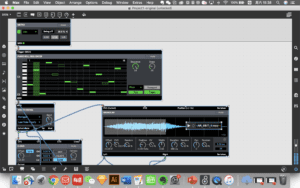
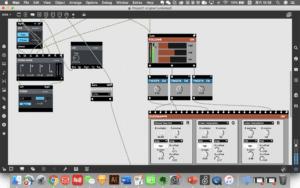
For the video part, I used 3EASEMAPPR to control the background-color changing all the time as to create the mysterious feeling of the cube building. Two 1EASEMAPPR are used to create lines of lights to intersect with each other so as to create both light interactions and a kind of transparency of the cube:
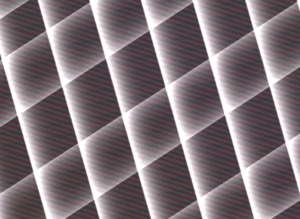
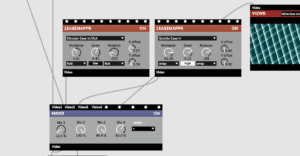
Patch’s link to GitHub: https://gist.github.com/Ellen25/906f5ebae386540c2b3cbf67ba01e612
Presentation
To be honest, my presentation did not go well. The only thing I feel like quite good is that the audio reached my expectation as some classmates commented that it fits well with my theme and it reminded them of video games or comics. For the video, firstly, I want to apologize for my misunderstanding and carelessness of reading the prompt as I had an outside resource of video included. By the same token, the video clip did not run as how it is shown on my computer. But I want to be grateful to everyone in the class that day as they offer me a lot of options that I can improve and also the ways for me to improve, which is unexpected for me. For example, my color changes were not clear and strong, thus it would be better if some strong contrast colors are included.
Conclusion
As Eric mentioned in class, my project is a good point to start, but there is still a lot I can do. The most important change needed to be made is in the video part. Except for the color improvement mentioned before, the light effect should also be improved as it is just still light dots and lines which have no relationship to the rhythm. This is basically due to my lack of research as I did not have abundant research for Mary Bute and deeper understanding of her use of lights in her works. For the creation part, my understanding of the basic logic of MAX is not clear enough to let me organize the patch fluently. I was improving my skill of using MAX through the process, but it is not enough for me to create a wholesome project at that time.
Therefore, after the presentation, I spent a bunch of time on revising my project, and here is the final adjusted version of it:
https://gist.github.com/Ellen25/1809fe8fcfc7db86597266625772afba
I mainly did the adjustment to the video part, extended my understanding of the building of Rubik’s cube to the shaking or even the crush of the cube. By adding one more 1EASEMAPPR with 2TONR and HUSALIR connected to it, I created a background with a stronger contrast in color. And the fuzzy light created a feeling of the destruction of the cube, which matches the dystopian cube building idea better. I kept the 3EASEMAPPR to create a fuzzy background with plenty of lines and also kept one of the 1EASEMAPPR to create a kind of transparency of the cube.
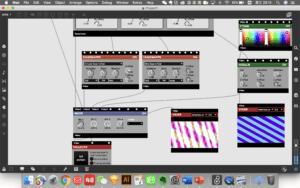
The video clip and a screenshot are shown below:
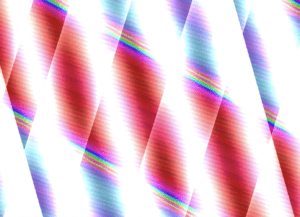
In conclusion, I have learned a lot during the whole process. The most inspiring part is the presentation and my self-reflection afterward, which stimulated me to rethink and revise my project. Through the whole process, my idea towards the building of Rubik’s cube is clearer, although, in the final adjusted version, it crushed. From a shallow beginning of an idea to a better understanding of a theme, a lot more research is needed, which is what I need to catch up, as well as the technical skill of MAX.